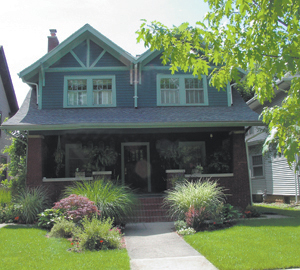DISCOVER OAKDALE’S HOME AND GARDEN TOUR

Featured Homes and Gardens:
•3401 Indiana Avenue: Prairie Style, c. 1920.
Arthur and Elsie Haeger were early owners of this excellent Prairie Style home located at the corner of Kinsmoor and Indiana. Kinsmoor Avenue was once called “Organ Street” when the famous Packard Piano Company was located nearby. French doors, built-in-bookcases, and fireplace are among the prairie features found within. The original blue prints are on display, as is a workbench from the Packard Piano factory.
•1010 West Oakdale Drive: Craftsman, c. 1920
This Craftsman style home had been vacant for several years when the current homeowners rolled up their sleeves and got to work. Much of the home had been last “modernized” in the 1960’s, and the current owners have updated several areas, and returned others to more Craftsman-style appearance. The garden features many lovely perennial plantings and ornamental grasses, near a fountain.
•1006 West Oakdale Drive: Dutch Colonial Revival, c. 1920.
Judge Otto and Maud Grant built this home, and began the garden in 1920. The second owners of the home purchased the property 37 years ago. The garden has continually evolved from the days of Judge Grant and features long-time favorites and an extensive Daylily collection.
•628 West Oakdale Drive: Prairie-American Foursquare, c. 1921.
Behind this home, built for Dr. Gillie, a popular sheriff and US Congressman for Northeastern Indiana during the early 20th century, can be found a shady grotto style garden. The design was prompted by the six towering oak trees, limiting sunlight. The retreat is naturally air-conditioned by these graceful giants.
•625 West Oakdale Drive: Colonial Revival, c. 1914
Henry and Louise Freese had this fine brick home built for them in 1914. It was designed by Lloyd W. Larimore, a prominent local architect who designed Tudor Revival and Colonial Revival homes both here in Oakdale and also along Old Mill Road. The exterior features paired and triple windows, with multi-light upper sashes, and several topped with arches. A decorative roof balustrade crowns the columned entry portico. The arched dormer window mirrors the arched window over the entry door. Inside can be found hardwood floors, Dutch antiques, and several built in cabinets. The solarium retains its original tile floor.
The garden features an enclosed “secret garden” separated from the main yard by masonry walls, which features many container plantings under the large shade trees.
•526 West Rudisill Boulevard: Mission/Prairie Bungalow, c. 1920.
Benjamin and Eualie Polack were fascinated by the California Bungalow style, and designed this house as a result. It has a unique atrium in the hallway, measuring 10 feet by 30 feet, with a stained glass ceiling, and concrete floor. The owners have restored moldings, re-hung the French doors, and have updated all of the mechanical systems in the home.
When the current owners first purchased the home, the garden had not been updated in about 40 years. The current owners spent several years creating a successful English style garden, which soon exceeded the garden area.
•3814 Fairfield Avenue: Craftsman, c. 1915.
This Craftsman style home has had many owners over the years, and the current owners have focused much of their efforts to return the home to sound condition, while maintaining its architectural integrity. The home features oak trim work on the main floor, with pine on the second. The homeowners are both artists, and own the Artisan Gallery. Their work, and the works of other local artists will be featured.
The garden features perennial flowers and grasses. The owners have recently created the cedar trellises along the fence, each inlaid with stained glass. They have also installed stained glass in the garage windows as well, in order to provide four seasons of color to the garden.
•501 West Oakdale Drive: Colonial Revival, c. 1920
Charles and Ethel Kendrick had this home built for them. The home features a first floor sunroom, and a unique sleeping porch on the second floor, that has an accordion-style wall, that opens to the outside. The interior has been updated with bright colors.
•429 Englewood Court: Colonial Revival, c. 1925
Interior Designer Scott Fritz and wife Ann have enjoyed the process of updating this gracious Colonial Revival home, while keeping such classic features. The home features a large living room with French doors that lead to an adjoining summer porch. A colonial style fireplace and hardwood floors can also be found in the main living room, hardwood continues into the dining room as well. These rooms are furnished with English and American antiques.
The garden envelopes the home, and includes perennial plantings of lavender, lilies, foxglove, yarrow, and other favorites. Flowering shrubs include oakleaf hydrangea, viburnums, rhododendrons, hemlocks and boxwood.
•422 West Oakdale Drive: Colonial/Georgian Revival, c. 1930.
Thomas and Maude Murphy had this Georgian-inspired Colonial Revival home built for them for $11,386.50, in 1930, and lived here until 1966. After brief ownership, the home was again occupied for another thirty-five years by another set of owners, neither of which had children. The home features built-in cupboards and library shelving, along with hardwood floors, French doors, and other details.
OAKDALE NEIGHBORHOOD FACTS
Oakdale Neighborhood, located east of Foster Park, is listed on the National Register of Historic Places. At the beginning of the 20th century Fort Wayne was on the move. After a 1910 lecture by Charles Mulford Robinson—a national proponent for civic beautification—Fort Wayne rushed to create a more attractive city. The nationally prominent landscape architect George Kessler was hired in 1911 to design a system of interconnected parks and boulevards. This plan was followed to great extent, and many of the city’s wide tree-lined boulevards originated with the Kessler plan. Several suburban developments were planned adjoining the Kessler system, including the area now known as Oakdale Neighborhood. Oakdale Drive, Arcadia Court and Englewood Court were platted and developed by Hilgeman and Schaaf—a local company, beginning in 1912. All of these comprise the Oakdale National Register District.
The Oakdale Historic District is primarily significant for its early 20th century residential architecture. Largely constructed between 1915 and 1930, the homes represent the popular Craftsman, Colonial Revival, Dutch Colonial Revival, American Foursquare and Tudor styles. Rare examples of the Mission Revival and Prairie styles also exist in the district. At least 8 homes are known to have been designed by such prominent local architects as Lloyd Larimore, Alvin Strauss, Guy Mahurin and Joel Ninde.
- Community Invited To Paint Rocks For Urban League Project - April 26, 2024
- May Events & Worship - April 26, 2024
- PBS Fort Wayne Hosts Open House - April 26, 2024


